Keeping your lawn healthy and vibrant involves more than just regular watering and mowing. Pest control, particularly applying insecticide, plays a vital role in maintaining a lush and pest-free lawn. Insects like grubs, chinch bugs, and sod webworms can wreak havoc on your grass, causing unsightly brown patches and irreversible damage if left unchecked. By utilizing insecticides, you can protect your lawn from these destructive pests and ensure its overall well-being.
Signs of Insect Infestation in Your Lawn
Recognizing the signs of insect infestation is crucial for timely intervention. Common indicators include thinning grass, brown patches that do not respond to watering, and sudden appearance of birds or other wildlife digging for insects in your lawn. If you notice any of these signs, it’s essential to take prompt action to prevent further damage to your lawn.
Factors to Consider Before Applying Insecticide
Before applying insecticide to your lawn, several factors should be taken into account. These include the type of grass you have, the severity of the infestation, and environmental considerations. Choosing the right insecticide that targets the specific pests plaguing your lawn is crucial for effective pest control.
Determining the Right Time to Apply Insecticide to Your Lawn
Timing is key when it comes to applying insecticide to your lawn. Late June to early August is generally recommended as the best time for preventive insecticide application to combat pests like white grubs. By following this timeline, you can protect your lawn during the critical periods when these pests are most active, ensuring optimal results.
Steps to Properly Apply Insecticide on Your Lawn
Proper application of insecticide is essential for maximizing its effectiveness and minimizing potential harm to the environment. Always follow the manufacturer’s instructions carefully, wear protective gear, and avoid overuse. Applying the insecticide evenly across your lawn and watering it in after application can help ensure thorough coverage.
Alternative Methods for Insect Control in Lawns
While insecticides are a common method for pest control, there are alternative options worth considering. Natural predators, beneficial nematodes, and maintaining a healthy lawn through proper watering and fertilization can also help reduce the infestation of harmful insects without the need for chemical treatments.
Monitoring and Evaluating the Effectiveness of Insecticide Application
After applying insecticide to your lawn, it’s essential to monitor its effectiveness. Keep an eye on the condition of your grass, look for signs of pest activity, and make adjustments as needed. Regular evaluation will help you determine if reapplication is necessary or if additional measures are required to maintain a pest-free lawn.
Conclusion
Applying insecticide to your lawn at the right time and in the proper manner is crucial for protecting your grass from damaging pests. By understanding the signs of infestation, considering key factors before application, and exploring alternative control methods, you can maintain a healthy and pest-resistant lawn. Remember to monitor the effectiveness of your pest control efforts and make adjustments as needed to ensure a beautiful and vibrant outdoor space.

